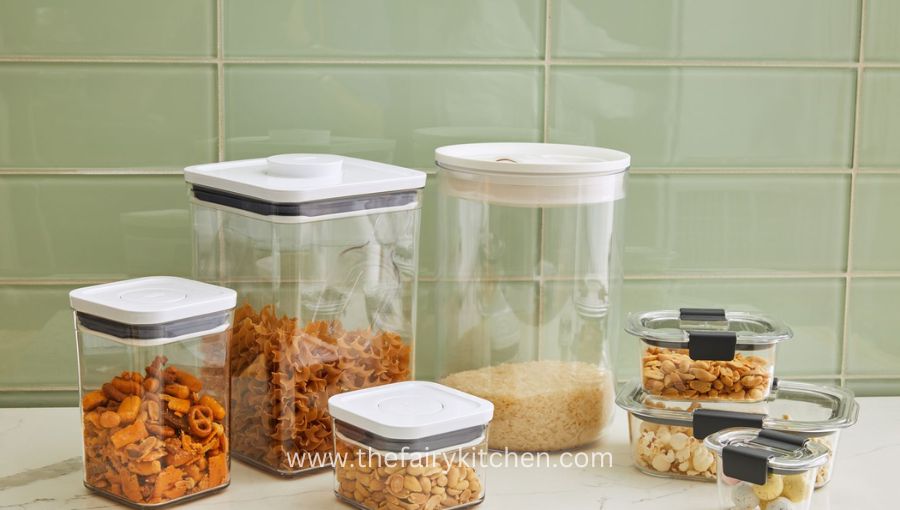Every product is independently reviewed and selected by our editors. If you buy something through our links, we may earn an affiliate commission at no extra cost to you.
Plastic containers labeled with the recycling codes 2, 4, and 5, are generally considered safe for food storage. These codes indicate that the containers are made from high-density polyethylene (hdpe), low-density polyethylene (ldpe), or polypropylene (pp), which are food-grade plastics.
When storing food, it is crucial to choose the right containers to ensure the safety and quality of your food.
With various plastic options available, it can be confusing to determine which ones are safe for food storage.
However, by looking for specific recycling codes, you can easily identify plastic containers that are suitable for this purpose.
In this article, we will discuss the different types of plastic containers and their respective recycling codes to help you make informed choices for your food storage needs.
The Impact Of Plastic Containers On Food Safety
Plastic containers have become a popular choice for food storage due to their convenience, affordability, and versatility.
However, it’s important to note that not all plastic containers are created equal. The type of plastic used, as well as its quality and condition, can greatly affect the safety of the food stored in them.
Here are some key points to consider:
Plastic containers can release chemicals into the food they hold, especially when exposed to heat or acidic foods.
These chemicals, such as bisphenol a (bpa) and phthalates, can potentially leach into the food and pose health risks.
Different types of plastics have different properties in terms of their ability to resist chemical leaching.
For example, containers made from polyethylene (pe) and polypropylene (pp) are generally considered to be safer options as they are less likely to release harmful chemicals.
It is crucial to check for any cracks, scratches, or signs of wear and tear in plastic containers, as they can provide breeding grounds for bacteria and make it more challenging to clean effectively. Damaged containers should be replaced to ensure food safety.
The Various Factors To Consider When Choosing Food Storage Containers
Selecting the right food storage containers involves considering several factors to ensure the safety and freshness of your food.
Here are some key points to consider:
- Choose containers that are specifically labeled as food-safe or food-grade. These containers are designed and tested to meet strict standards for food storage.
- Opt for containers that are made from materials known to be safe, such as glass, stainless steel, or food-grade plastic like polyethylene (pe) and polypropylene (pp). These materials are less likely to leach harmful chemicals into your food.
- Consider the container’s ability to effectively seal and prevent leakage. Airtight containers can help keep your food fresh and reduce the risk of contamination.
- Look for containers that are easy to clean and maintain. Dishwasher-safe options are convenient and ensure thorough cleaning.
The Potential Health Risks Associated With Unsafe Containers
Using unsafe containers for food storage can potentially expose you and your loved ones to various health risks.
Here are some key points to be aware of:
- Chemicals leaching from certain plastic containers can disrupt hormonal balance and have negative impacts on human health, especially in vulnerable populations such as infants and pregnant women.
- Bacteria and mold can grow and thrive in containers with cracks, scratches, or damaged seals, leading to food contamination and potential foodborne illnesses.
- Unsafe containers may not effectively preserve the quality and freshness of your food, resulting in spoilage and waste.
By understanding the importance of safe food storage containers, considering the impact of plastic containers on food safety, and being aware of the potential health risks associated with unsafe containers, you can make informed choices to protect yourself and your family.
BPA-Free Containers – Are They The Safest Option?
Bisphenol a (bpa) is a chemical used in the production of certain plastics and resins and has been widely used in food containers for many years.
However, concerns about the potential health risks associated with bpa have prompted the development of bpa-free food storage containers.
Let’s take an in-depth look at bpa and explore the potential health risks it poses. Finally, we’ll understand the benefits of choosing bpa-free containers as a safer alternative.
An In-Depth Look At Bisphenol A (BPA)
- BPA is a chemical that has been used in the production of polycarbonate plastics and epoxy resins, both commonly used in food storage containers.
- It is known to leach into food and beverages, particularly when the containers are heated or come into contact with acidic foods or liquids.
- The presence of bpa in the body can mimic the hormone estrogen, potentially disrupting the endocrine system and leading to adverse health effects.
Exploring The Potential Health Risks Associated With BPA
- Research studies have linked bpa exposure to various health issues, including reproductive problems, developmental delays, and an increased risk of certain cancers.
- Young children and infants are considered more vulnerable to the potential health risks of bpa due to their developing systems and higher food consumption relative to their body weight.
- Regulatory agencies have set limits on the use of bpa in certain products, emphasizing the need for safer alternatives in food storage containers.
Understanding The Benefits Of BPA-Free Food Storage Containers
- Bpa-free containers are made from alternative materials that do not contain or leach bpa into food and beverages, reducing the risk of exposure.
- Some common bpa-free materials include glass, stainless steel, and certain types of plastics, such as those made from polypropylene or high-density polyethylene (hdpe).
- Choosing bpa-free containers provides peace of mind, particularly for individuals concerned about potential health risks associated with bpa exposure.
- Bpa-free containers are widely available and come in various shapes and sizes, making it easy to find suitable options for your food storage needs.
Bpa-free food storage containers offer a safer alternative to traditional containers that may contain bisphenol a. By understanding the potential health risks associated with bpa and choosing bpa-free options, you can make more informed decisions about the containers you use to store your food.
Consider opting for materials like glass or stainless steel or look for plastics labeled as bpa-free to ensure you’re prioritizing the safety of your food and well-being.
What Does It Mean For A Container To Be “Food-Grade”?
When searching for plastic containers for food storage, you may come across the term “food-grade. ” But what exactly does it mean for a container to be labeled as such?
Let’s take a closer look:
- Food-grade refers to the quality and suitability of a container for safely storing food items. Containers labeled as food-grade are specifically designed and manufactured to meet certain standards to ensure food safety.
- Food-grade containers are made with materials that are safe for contact with food. These materials are free from harmful chemicals and additives, such as bpa (bisphenol a) and phthalates, that can potentially leach into the food and pose health risks.
- Identifying food-grade containers is crucial because using non-food grade containers can result in chemical contamination and compromise the integrity and safety of the stored food.
- Look for labels or markings on a container indicating that it is food-grade. This ensures that it has been tested and approved for contact with food, giving you confidence in its safety.
- It’s important to note that food-grade containers are not only limited to plastic. They can also be made from materials like glass and stainless steel, which are considered inherently food-safe.
How to Identify Reliable Food-Grade Certifications
When it comes to food-grade certifications, there are a few that you can look out for to ensure the safety of the plastic containers you choose:
- Nsf international certification: Nsf certification ensures that the plastic container meets the necessary standards for food safety and quality. It is recognized globally and indicates that the container has undergone rigorous testing and evaluation.
- Bpa-free certification: Bisphenol a (bpa) is a chemical that has raised concerns due to potential health risks. Choosing bpa-free certified containers can help reduce the risk of exposure to this compound.
- Astm international certification: Astm international sets industry standards for various products, including plastic containers. Choosing containers with astm certifications ensures compliance with recognized safety standards.
- It is always advisable to do your own research and look for certifications from trusted organizations to verify the food-grade status of a plastic container. Checking the manufacturer’s website or contacting customer support can also provide additional information.
Fda approval and food-grade ratings are essential factors to consider when selecting plastic containers for food storage.
How To Properly Store Plastic Containers To Maintain Their Safety And Longevity
Properly storing your plastic containers is essential to ensure their safety and longevity. Consider these tips to keep your food storage containers in good condition:
- Separate lids and containers: Store the lids separately to prevent them from getting misshapen or misplaced. This also allows for better organization and ease of use.
- Stack containers by size: Stack the containers by size, with the largest at the bottom and the smallest on top. This saves space and makes it easier to access the desired container.
- Utilize drawer dividers or organizers: Use drawer dividers or organizers to keep the containers neatly arranged, preventing them from toppling over or becoming disorganized.
- Avoid stacking too many containers: Avoid overstacking containers, as this can lead to deformation or damage. If necessary, consider investing in additional storage options to accommodate your collection.
- Store in a cool and dry place: Keep your plastic containers in a cool and dry environment to prevent them from deteriorating. High temperatures can cause the plastic to weaken or warp.
- Regularly inspect for damages: Periodically check your containers for any signs of cracks, discoloration, or wear and tear. If you notice any damage, it’s best to replace the container to ensure food safety.
Remember, adhering to proper cleaning practices and storing your plastic containers correctly will not only maintain their safety and longevity but also provide you with peace of mind when using them for food storage.
Conclusion
Choosing the right plastic containers for food storage is essential for maintaining our health and the quality of our meals. By understanding the various types of plastics and their safety ratings, we can make informed decisions about which containers to use.
It is important to look for containers labeled with the recycling codes 1, 2, 4, and 5, as these are generally considered to be safe for food storage. Additionally, opting for bpa-free containers can further minimize the potential risks associated with plastic food storage.
Glass and stainless steel containers are also excellent alternatives, providing a safe and eco-friendly option for storing our meals. By prioritizing safety and making conscious choices, we can ensure that our food stays fresh and healthy, without compromising our well-being.
So the next time you reach for a plastic container, remember to check the recycling codes and make a choice that works best for you and your family.

